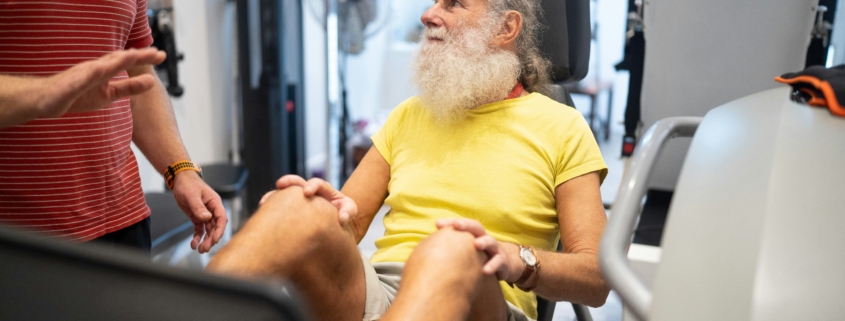Strong at Any Age: A Friendly Gym Guide for Over‑50s in Brighton
Last updated: November 18th 2025
Summary: Strength training and gentle conditioning are safe and highly effective for healthy adults 50+. Start 2–3 days/week, focus on big movements (push, pull, hinge, squat), use RIR 2–3 (a couple reps left in the tank), and prioritise protein, sleep, and steady progression. This guide is for anyone searching for an over 50s gym Brighton—friendly, joint-smart training you can actually stick to.
Table of contents
- Why train in your 50s, 60s, and beyond
- Is it safe? (and how we keep it that way)
- Getting started: simple weekly plan
- Joint‑friendly exercise swaps
- Warm‑up, mobility, and recovery
- Fueling for strength after 50
- Common concerns & quick answers
- FAQs
- Book a chat or try a session
- Locations we serve
- Author & sources
Why train in your 50s, 60s, and beyond
- Build strength & independence: lift shopping, garden, play with grandkids with ease.
- Protect joints & bones: resistance work helps maintain bone density and joint support.
- Heart & brain health: regular training supports cardiovascular fitness and cognitive function.
- Pain & posture: stronger glutes, back and core often reduce day‑to‑day aches.
- Mood & sleep: movement improves sleep quality and energy.
You don’t need “beast mode.” You need consistent, smart training that respects recovery.
Is it safe? (and how we keep it that way)
For most healthy adults, yes. We:
- Start with a 10–15 minute consultation to learn your history (joints, medications, blood pressure, surgeries).
- Use technique‑first coaching and the RIR method (finish most sets with 1–3 reps left).
- Progress in small jumps (1–2.5 kg), and schedule deloads every 4–6 weeks if needed.
- Offer machine and free‑weight options so you can choose what feels best.
Medical note: if you have a health condition, we’ll work with any clinical guidance you have. When in doubt, check with your GP before starting.
Getting started: Over 50s Gym Brighton: Joint-Friendly Plan
Aim: 2–3 strength sessions/week + optional low‑impact cardio (walking, bike, swim) on other days.
Option A — 2‑day full body (45–60 min)
- Squat to box or Leg Press — 3×8–10 (RIR 2)
- Machine Row — 3×8–12 (RIR 2)
- Dumbbell Bench or Chest Press — 3×8–12 (RIR 2)
- Hip Hinge: Kettlebell Deadlift or Hip Thrust — 3×8–10 (RIR 2–3)
- Anti‑rotation/Core: Cable Pallof Press — 2–3×10–12
- Finisher: 5–8 minutes easy bike/walk
Option B — 3‑day full body (40–60 min)
- Day 1: Trap‑bar Deadlift 3×6–8, Assisted Pull‑down 3×8–10, DB Split Squat 2×8/leg, Incline DB Press 3×8–10
- Day 2: Leg Press 3×10, Machine Row 3×10–12, Hip Thrust 3×8–10, Shoulder Press Machine 2–3×8–10
- Day 3: Goblet Squat 3×8–10, Chest Press 3×8–10, Seated Cable Row 3×10–12, RDL 2×8, Farmer Carry 3×20–30 m
Progression: when you hit the top of the rep range with good form on all sets, increase weight slightly next time.
Bookmark this page if you’re comparing over 50s gym Brighton options and want a plan that respects joints and recovery.
Joint‑friendly exercise swaps
- Knees: Swap back squats → leg press or box squat; lunges → split squat holding onto support.
- Shoulders: Barbell overhead press → machine press or neutral‑grip DB press.
- Lower back: Conventional deadlift → trap‑bar deadlift or hip thrust.
- Wrists/elbows: Straight‑bar curls → EZ‑bar or cable handles.
Green Gym Group has trap bars, cable stations, and benches set up for easy adjustments—ask a coach to fit the equipment to you.
Warm‑up, mobility, and recovery
- Warm‑up (5–8 min): brisk walk/bike + 2 light sets of your first exercise.
- Mobility: choose 2–3 feel‑good moves (e.g., calf raises, hip openers, thoracic rotations).
- Rest times: 60–120 sec for moderate sets; up to 2–3 min on heavy moves.
- Recovery: sleep 7–9 hours, gentle walks on rest days, and respect any joint niggles.
Fueling for strength after 50
- Protein target: aim for 30–40 g at meals/snacks, especially post‑workout.
- Carbs: include fruit, wholegrains, and potatoes around training for energy.
- Hydration: keep water handy; consider electrolytes in hot weather or longer sessions.
- Quick ideas: skyr/cottage cheese + fruit; eggs on toast; chicken/bean wrap; whey/soy shake + banana.
Common concerns & quick answers
- “Will lifting hurt my joints?” With joint‑smart moves and moderation, most people feel better, not worse.
- “Am I too old to start?” You’re not. Strength responds at any age with the right plan.
- “Do I need to be fit before I join?” No—we meet you where you are.
- “I’ve got high blood pressure.” We avoid breath‑holding (Valsalva), favour controlled sets, and can tailor rest and tempo. Bring your readings if you track them.
FAQs
How many days should I train at 50+?
Start with 2–3 days/week of strength, plus walking or cycling on other days.
How hard should sets feel?
Finish most sets with 1–3 reps in reserve (RIR)—challenging but not straining.
What if I have arthritis?
Use joint‑friendly variations, keep reps 8–12, and warm up gradually. If a move hurts in a sharp way, we switch it.
Do I need supplements?
Not essential. Many members do well with regular food; a whey/soy protein is just convenience.
Can I build muscle after 60?
Yes—slower than in youth, but very possible with consistent training, protein, and recovery.
Book a chat or try a session
- Consult (10–15 min): talk through joints, goals, and a starter plan.
➡️ Book a friendly intro Tour - Try the gym: tour the kit and sample a session at your pace.
➡️ Start a free trial
Locations we serve
Green Gym Group — Kemptown Brighton
Address: 39 – 40 St James’s Street, BN21RG
Phone: 01273 625577
Hours: Mon–Sun 6am–10pm
Sources
(plain‑English summaries)
- Resistance training supports strength, function, and bone health in older adults.
- Progressive overload works at any age; start moderate and progress gradually.
- Protein spacing (30–40 g/meal) supports muscle maintenance in older adults.



